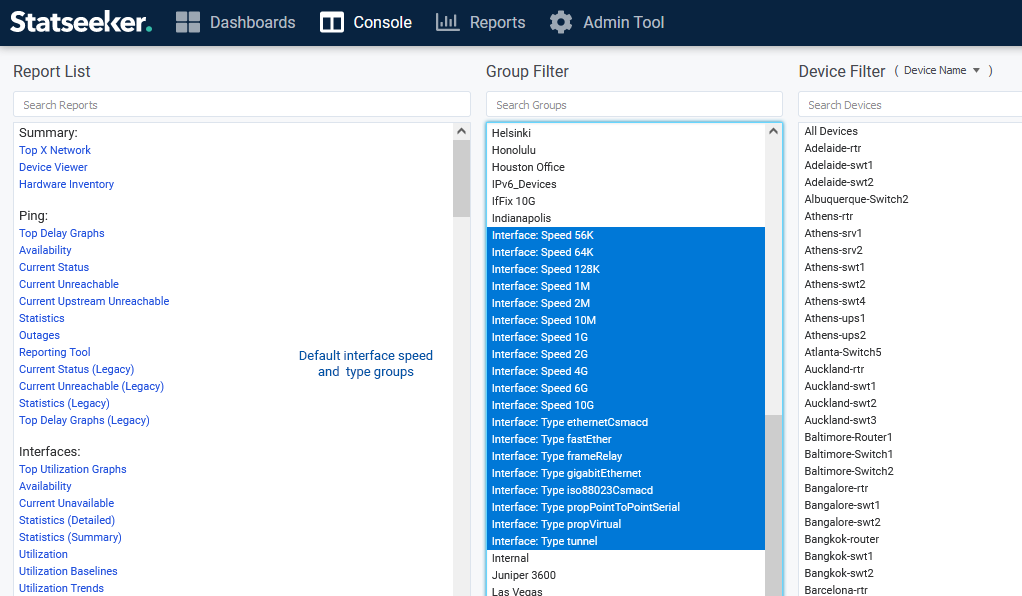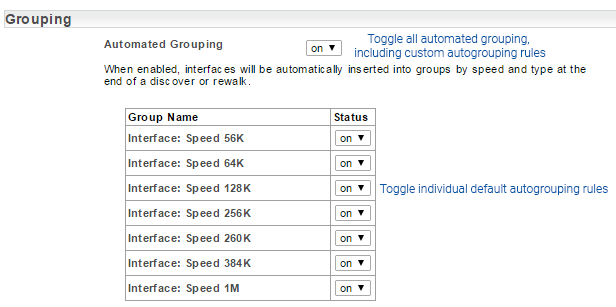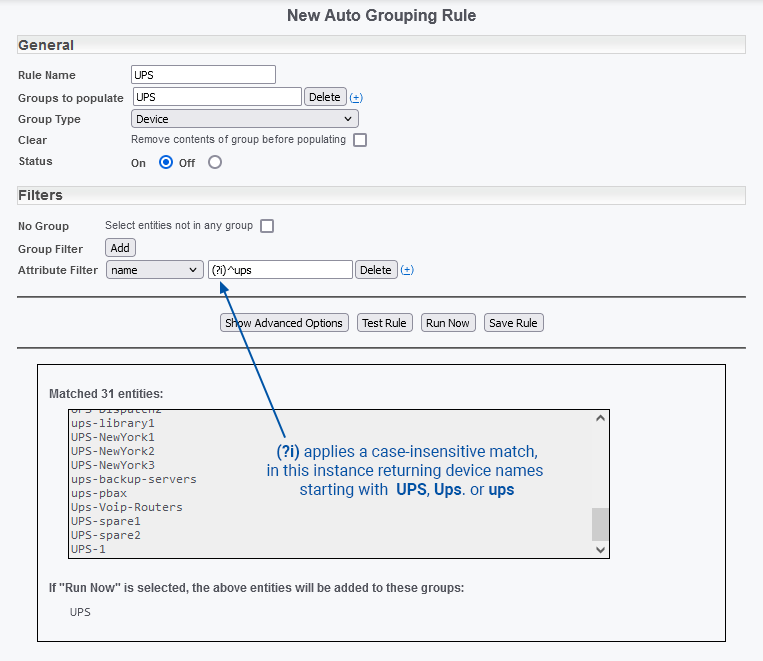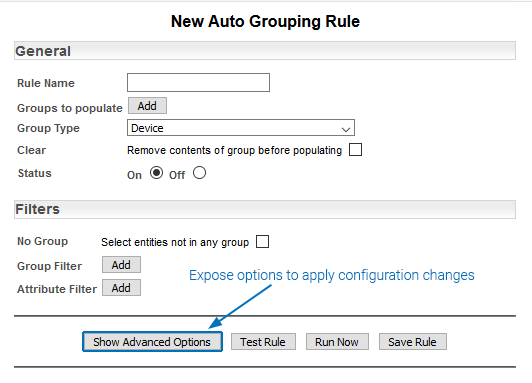** Legacy Documentation for Statseeker v5.6.1 **
Index
- Overview
- Creating Automatic Grouping Rules
- Editing Automatic Grouping Rules
- Enabling/Disabling Automatic Grouping
- Ordered Automatic Grouping
Example Configurations
- Grouping all Switches by Device Name
- Grouping select Switches by Parent Group and System Location
- Grouping Devices by Subnet
- Grouping Devices by Subnet with an Exception Filter
- Group UPS devices by Device Name - Case Insensitive
- Create a "Catch-All" with Group Ordering + "No Group"
- Group by Device/Interface Event Fields
- Use Auto-Grouping to Apply Bulk Configuration Changes
Overview
Grouping is a fundamental feature in the Statseeker product, it is a core mechanic utilized by:
- Reporting
- Thresholds
- Alerting
- Visibility and access control
- Filtering response data when utilizing the API
Auto-Grouping can also be used to assist with infrastructure maintenance, as well as highlighting poorly configured hardware or hardware that is mis-representing its actual configuration.
All enabled Auto-grouping rules are run as a component of the discovery process, and during Statseeker's daily rewalk of the network.
Creating Automatic Grouping Rules
You can add your own automated grouping rules from the Administration Tool:
- Select Administration Tool > User Profile/Grouping > Auto Grouping
- Select Add
- Enter a Rule Name
- Specify the groups to be populated by the rule
- Enter text into the Groups to populate field and you will be provided the options to either create a new group or select an existing group based on that text
- Use the (+) link to add additional groups in to populate multiple groups from a single rule
To create new rule:
The rules used to populate the nominated groups are created via a combination of Group Type and Filters.
- Specify the Group Type - the type of entity that the rule will add to the group/s. Only a single Group Type can be specified per Auto-Grouping rule, but multiple Auto-Grouping rules can be configured to populate a single group.
- Specify one or more Filters
- Use Test Rule to preview the effects of the rule being applied
- Select Run Now to process rule, creating and populating groups
- Select Save Rule to save the configuration for future application

- Configuring a device group and an interface filter will select the parent device of any interface matching the filter
- Configuring an interface group and a device filter will select all interfaces on matching devices
- The Clear checkbox will remove all contents of the specified groups before re-populating them, useful when refining a rule or updating a group in response to changes within your network. The Clear setting:
- May be undesirable when multiple rules populate a single group, a single Clear will remove the output of all rules
- Will remove content that has been manually added to the group outside of any auto-grouping configuration
- Multiple filters for the same attribute will conflict, instead use a regular expression e.g. swt|switch|Switch
- The ipaddress filter requires one or more scan ranges, the following syntax rules apply:
- Can be specified using the same syntax as IP Range Scan Ranges used by the Discovery process
- Filter values without an include or exclude prefix are treated as an include e.g. 10.2.1.[4,6,10-12] = include 10.2.1.[4,6,10-12]
- Multiple rules can be supplied in the filter e.g. include 10.2.1.0/24 exclude 10.2.1.[4,6,10-12]
- When specifying multiple rules, the prefix is applied to all values until the next prefix is encountered e.g. include 10.2.1.0/24 10.2.[4-6].* exclude 10.2.1.[4,6,10-12]
- Multiple group filters are OR'd together, an entity existing in either group is considered valid
- Multiple attribute filters are applied in an AND fashion, all must be satisfied for an item to be added to the specified group/s
- An AND operator exists between the Group filters and the Attribute filters when both are supplied - an entity must satisfy both the group filters (as a block) and the attribute filters (again, as a block) to be considered valid for the grouping rule.
Group and Attribute Filter Logic: (group_filter1 OR group_filter2 OR group_filterN) AND (attribute_filter1 AND attribute_filter2 AND attribute_filterN)
Editing Automatic Grouping Rules
The list of Auto grouping rules can be filtered:
- By Name by typing in the search field (case-insensitive RegEx enabled)
- By Status via the Show All drop-down above the column
To edit existing automated grouping rules:
- Select Administration Tool > User Profile/Grouping > Auto Grouping
- Click either the rule name or the associated checkbox to select the rule
This will populate the rule configuration pane with the selected rule.
- Modify the rule as required, optionally click Test Rule to preview the effects of the rule being applied
- Select Run Now to process the new rule
- Select Save Rule to save your changes for future discovery/rewalking processes
Copying an Existing Rule
Existing rules can be copied and edited to produce a new rule configuration. To copy a rule:
- Select Administration Tool > User Profile/Grouping > Auto Grouping
- Click either the rule name or the associated checkbox to select the rule
- Click Copy
A new rule configuration will be created, but not saved, amend the configuration as needed (optionally test the rule) and be sure to save the rule prior to leaving the configuration screen.
Enabling/Disabling Automatic Grouping
To enable/disable user-created automatic grouping rules:
- Select Administration Tool > User Profile/Grouping > Auto Grouping
- Click to select the rule/s and click Enable/Disable
The rule will no longer be applied but will remain in the Auto Grouping Rules list for future reference.

To disable user-created automatic grouping rules from within the rule configuration:
- Select Administration Tool > User Profile/Grouping > Auto Grouping
- Click to select the rule, populating the configuration panel
- Set Status to Off
- Click Save Rule
The rule will no longer be applied but will remain in the Auto Grouping Rules list for future reference.

By default, Statseeker also creates hidden auto-grouping rules for every interface speed and type encountered during discovery, the output of these rules can be seen in the Console.

To disable a default Statseeker Automatic Grouping rule:
- Select Administration Tool > Network Discovery - Advanced Options > Advanced Options
- Scroll down to the Grouping section
- Toggle the status for select rules or all automated grouping rules (both default and user-created rules)

Ordered Automatic Grouping
Automatic grouping rules are applied to your discoverable network in a defined order. This is important because you have the ability to create automatic grouping rules which affect the actions (or available targets) of another rule, further down the chain. Rules are applied from the top of the Auto-Grouping rules list, downward. By default, newly created rules are added to the bottom of the list. This order can be adjusted the order at any time, with the changes going into effect on the next discovery/rewalk.
To adjust the Auto Grouping Rules order:
- Select Administration Tool > User Profile/Grouping > Auto Grouping
- Click and drag a rule as required to reorder the listing
- The
 buttons can be used to move selected rules to the top/bottom of the list
buttons can be used to move selected rules to the top/bottom of the list
Changes to the Auto Grouping Rules order are applied immediately, there is no requirement to save the configuration.
Example Auto-Grouping Rule Configurations
- Beware of using the Clear setting when multiple rules are populating the target group
- The Clear setting removes all content, including entities that have been manually added to the group
Grouping all Switches by Device Name

Grouping select Switches by Parent Group and System Location

Grouping Devices by Subnet

Grouping Devices by Subnet with an Exception Filter

^((?!(stringToExclude)).)*$
- where stringToExclude defines the string to match, such as seen in the example above.
Multiple exclusions strings may be supplied with: ^((?!(stringToExclude1)|(stringToExclude2)|(stringToExclude3)).)*$
Combining Include and Exclude Terms
A combination of include/exclude can be submitted with something like (stringToInclude1|stringToInclude2).(?!(stringToExclude1)).*$. A filter of (Lisbon|Madrid).(?!(rtr)).*$ would return instances of Lisbon or Madrid, except for any instance of Lisbon-rtr or Madrid-rtr.
Group UPS devices by Device Name - Case Insensitive
Using a case-insensitive search to group UPS devices.

- (?i) - start case-insensitive matching
- (?-i) - end case-insensitive matching
Example
(?i)ups(?-i)-Commerce
- Matches UPS-Commerce and UpS-Commerce - any case instance of 'ups', but only proper-case 'Commerce'
- Will not match ups-commerce or UPS-COMMERCE
Use Group Ordering with a 'Catch-All' Rule to identify devices not catered to by other rules
Because auto-grouping rules are applied from the top of the list down, you can create a rule to run last which identifies all network devices not currently grouped. This is a simple, automated method of identifying all devices that existing auto-grouping rules do not cater to:
- If you utilize a good device naming convention, and group by this convention, then this type of rule will identify mis-named devices
- If you have added new devices or updated device configurations on existing devices, this type of rule will identify devices not being catered to by your grouping rules
Group by Device/Interface Event Fields
Statseeker v5.5 introduced the ability to reference interface level ifOperStatus and ifAdminStatus event fields when constructing auto-grouping rules.
When selecting these fields for an attribute filter, you choose whether to filter against:
- Poll = on/off - whether or not that interface has ifOperStatus/ifAdminStatus polling enabled
- Current State - the current value for the specified field, see Working with Filters for possible values
Group Interfaces with ifAdminStatus Polling Enabled
Group Interfaces with ifOperStatus set to Dormant
Use Auto-Grouping to Apply Bulk Configuration Changes
Auto-Grouping rules can also be used to apply bulk device/interface configuration changes on the Statseeker side. These configuration changes apply to Statseeker configuration fields for the entity, nothing is written back to the device.
To view the fields necessary to apply these sorts of changes:
- Click Show Advanced Options






